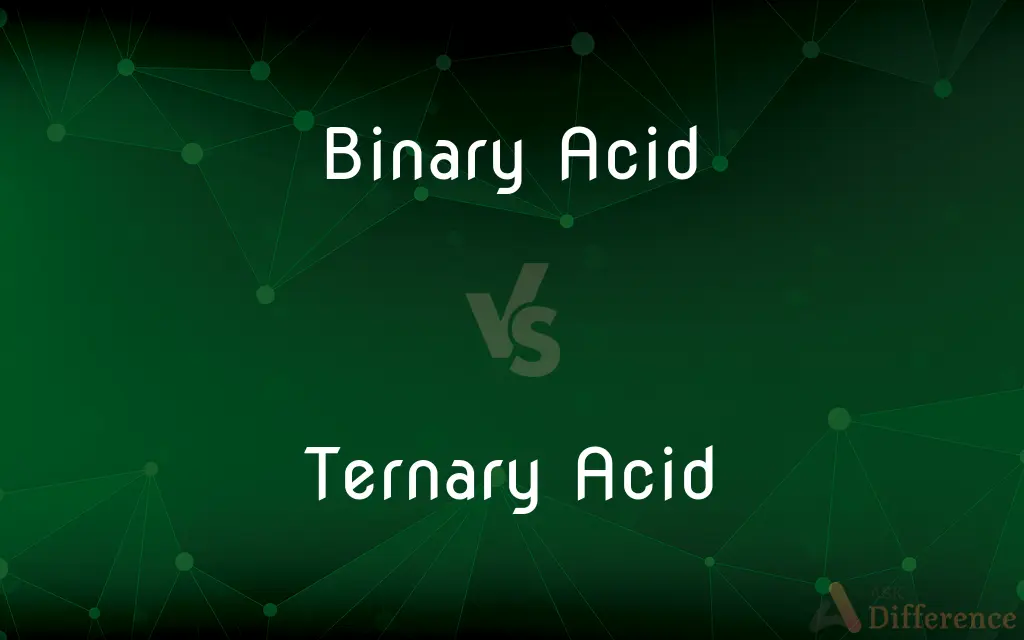Binary Acid vs. Ternary Acid — What's the Difference?
By Maham Liaqat & Urooj Arif — Published on September 5, 2024
Binary acids consist of hydrogen and one other element, known for their simplicity and solubility in water, while ternary acids contain hydrogen, oxygen, and a third element, often having a more complex structure and varied acidity.

Difference Between Binary Acid and Ternary Acid
Table of Contents
ADVERTISEMENT
Key Differences
Binary acids are composed of hydrogen and one other nonmetal element, forming simple molecular compounds. They are characterized by their strong solubility in water and tend to have straightforward names derived from the nonmetal element they contain. On the other hand, ternary acids consist of hydrogen, oxygen, and another element (usually a nonmetal), making their structure more complex. Ternary acids are often stronger than binary acids due to the presence of oxygen, which affects their acidity.
In terms of naming, binary acids use the prefix "hydro-" followed by the name of the other element with an "-ic" suffix, indicating their simple composition. For example, hydrochloric acid (HCl) is a common binary acid. Whereas ternary acids, also known as oxyacids, are named based on the polyatomic ion they contain and do not use the "hydro-" prefix, such as sulfuric acid (H2SO4), highlighting their more complex nature.
The strength of binary acids in water is generally determined by the bond strength between hydrogen and the other element; weaker bonds make stronger acids. In contrast, the strength of ternary acids depends on the electronegativity of the central atom (the one that is not hydrogen or oxygen) and the number of oxygen atoms, which can lead to a wide range of acid strengths.
Binary acids typically form when hydrogen gas reacts with nonmetal gases, a process that can occur under various conditions, including some industrial processes. Ternary acids are usually formed from the reaction of water with certain oxides, a process that involves more complex chemical reactions and can result in a variety of acid strengths based on the oxide used.
While binary acids are known for their simplicity and direct reactions, ternary acids offer a greater variety of chemical behaviors and applications due to their additional oxygen atom and the presence of another element. This complexity allows for a wider range of uses in industry, research, and technology.
ADVERTISEMENT
Comparison Chart
Composition
Hydrogen + 1 other element
Hydrogen + Oxygen + 1 other element
Naming
"Hydro-" prefix + element name + "ic" suffix
Based on the polyatomic ion contained
Structure
Simple molecules
More complex molecules
Acidity Determinants
Bond strength between H and the other element
Electronegativity of central atom and number of O atoms
Examples
Hydrochloric acid (HCl), Hydrofluoric acid (HF)
Sulfuric acid (H2SO4), Nitric acid (HNO3)
Compare with Definitions
Binary Acid
Acids composed of hydrogen and one other nonmetal element.
Hydrochloric acid (HCl) is used in various industrial applications.
Ternary Acid
Named based on the polyatomic ion they contain.
Nitric acid (HNO3) derives its name from the nitrate ion.
Binary Acid
Named with a "hydro-" prefix and "-ic" suffix.
Hydroiodic acid (HI) is a powerful binary acid.
Ternary Acid
Structure involves hydrogen, oxygen, and another element.
Phosphoric acid (H3PO4) includes phosphorus as the central element.
Binary Acid
Typically have simple molecular structures.
The molecular structure of hydrofluoric acid (HF) consists of just two atoms.
Ternary Acid
Contain hydrogen, oxygen, and a third element, usually a nonmetal.
Sulfuric acid (H2SO4) is a widely used ternary acid.
Binary Acid
Their strength is influenced by the bond between hydrogen and the other element.
The weaker bond in hydroiodic acid makes it a stronger acid.
Ternary Acid
The presence of oxygen affects their acidity.
The oxygen in sulfuric acid makes it a strong acid.
Binary Acid
Known for strong solubility in water.
Hydrobromic acid (HBr) dissolves readily in water to produce a strong acid solution.
Ternary Acid
Have varied strength based on their central atom and oxygen content.
The strength of nitric acid is influenced by its nitrogen and oxygen atoms.
Common Curiosities
What is an example of a binary acid and its use?
Hydrochloric acid (HCl) is a binary acid used in metal refining and pH adjustment in water treatment.
Why are binary acids named with a "hydro-" prefix?
The "hydro-" prefix in binary acids highlights their composition of hydrogen and one other nonmetal element.
What distinguishes a binary acid from a ternary acid?
Binary acids consist of hydrogen and one other element, while ternary acids also include oxygen in their composition.
How are ternary acids formed?
Ternary acids are typically formed by the reaction of water with certain nonmetal oxides, resulting in complex molecules containing hydrogen, oxygen, and another element.
What determines the strength of a ternary acid?
The strength of a ternary acid is determined by the electronegativity of the central atom and the number of oxygen atoms present.
Are binary acids more or less corrosive than ternary acids?
The corrosiveness of an acid depends on its strength and concentration, not directly on whether it is binary or ternary, though many ternary acids are stronger and potentially more corrosive.
How does the presence of oxygen in ternary acids affect their properties?
Oxygen generally increases the acidity of ternary acids compared to binary acids, due to its electronegativity and ability to stabilize the negative charge on the anion.
How does the naming convention of ternary acids differ from binary acids?
Ternary acids are named based on the polyatomic ion they contain, without the "hydro-" prefix, reflecting their more complex structure.
Is it possible for a binary acid to be stronger than a ternary acid?
While ternary acids are generally stronger due to the presence of oxygen, the strength of an acid also depends on other factors, such as the specific elements involved and their molecular structure.
Why do binary acids typically have simpler molecular structures than ternary acids?
Binary acids consist of only two elements, hydrogen and one nonmetal, leading to simpler molecular structures compared to ternary acids, which include an additional oxygen atom.
What factors influence the strength of a binary acid?
The strength of a binary acid is influenced by the bond strength between hydrogen and the other nonmetal element; weaker bonds result in stronger acids.
Can you name a ternary acid and its application?
Sulfuric acid (H2SO4) is a ternary acid used in battery acid, and in the manufacture of fertilizers and chemicals.
How are binary and ternary acids used in industry?
Both are used widely in industry for various purposes, including manufacturing, cleaning, and processing materials.
Can the composition of a ternary acid be altered to change its acidity?
Yes, changing the central atom or the number of oxygen atoms in a ternary acid can alter its acidity.
What role does the electronegativity of the central atom play in the acidity of ternary acids?
The greater the electronegativity of the central atom in a ternary acid, the more it can stabilize the negative charge on the anion, increasing the acid's strength.
Share Your Discovery

Previous Comparison
North Indian Food vs. South Indian Food
Next Comparison
CeraVe vs. CetaphilAuthor Spotlight
Written by
Maham LiaqatCo-written by
Urooj ArifUrooj is a skilled content writer at Ask Difference, known for her exceptional ability to simplify complex topics into engaging and informative content. With a passion for research and a flair for clear, concise writing, she consistently delivers articles that resonate with our diverse audience.













































